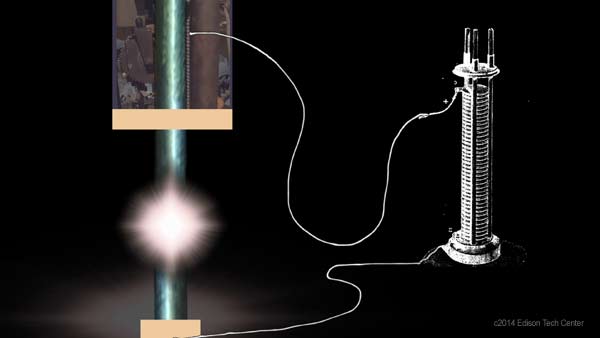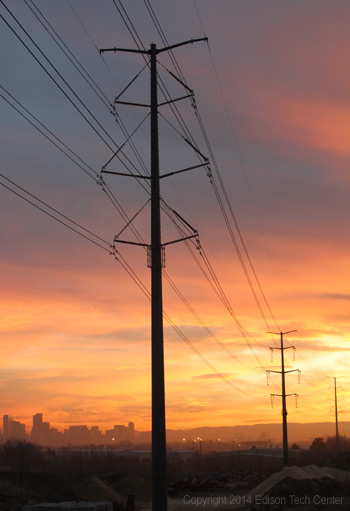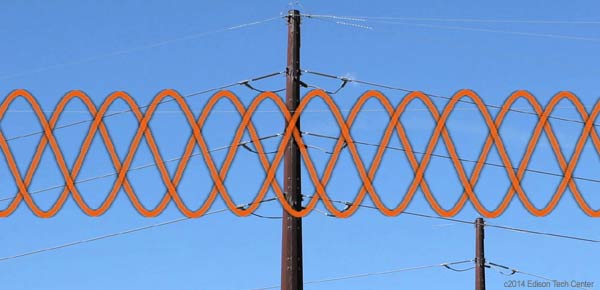Basics of Electricity
To learn how electricity works just click on any of the diagrams to learn more about each piece of the power system.
|
|
Basics of Basics:
The Edison Tech Center's diverse material covers the engineering and applications side of electricity (the fun part!). For basic science on 'what is electricity?' we recommend you start with this 2 minute video from Monkey See and then continue below.
Before working with electricity and tinkering with electrical products we urge you to be aware of the deadly and surprising forces at work. See our video below showing the effects of electric arcs on the human body:
1. Generation:
Energy cannot be created or destroyed, so in order to make electrical energy we must get it by converting it from another form of energy. Most power in the world is generated by converting hot steam into movement, which can be made into electricity.Most power generation in the world works similar to the model below, with some kind of turbine turning a shaft connected to a generator. Batteries, photovoltaics and some other forms of power generation are completely different.

|
Continue learning more about Power
Generation >
|
2. Types of Electric Power:
Batteries, fuel cells and PV produce Direct Current electrical energy and the others can produce either DC or AC depending on the generating unit.
Direct Current - the unidirectional flow of electrical chargeBelow: a simple Volta battery (1800) connected to a single arc lamp (two carbons with an arc between).
 |
Alternating Current (AC) - flow of electrical charge reverses direction periodically, in North American households this reverses polarity 60 times in a second, therefore we say it has a frequency of 60 Hertz or 60 cycle.
Any rotating motion (as created by steam turbines, hydropower, wind, etc) can be converted into electric power using a dynamo (DC power) or alternator (AC power).
Alternating current shown above is single phase, which means that it has only one source, but you can add together alternating current from other sources, sending it all on the same wire as long as the different electrical sources are well controlled. This helps with producing an almost solid flow of electricity similar to direct current. When many different sources of alternating current are used, this is called multiphase generation. In the graphic below you will see how three phase power looks:
|
Continue learning more about multiphase
power here >
|
 |
|
Power Transmission:
Each material has a different conductivity (ability to transmit electric power). Silver, Aluminum, Copper and Gold are some of the best conductors out there. Carbon nanotubes are also conductive and are a cutting edge technology. The thickness and type of wire you use varies depending on which application you are using it for.
Power Conditioning:
With AC power you can transmit over distance, but you must have a way to control the properties of electricity. Using certain devices you can control voltage, amplitude, frequency and the shape of the wave form. Power conditioning is all about manipulating the energy to make it ready to send over distance, then make it ready to perform work using the end device. Click on the item in the graphic below to learn more about it.
 |
|
Continue learning more about power
transmission here>
|
4. Power Applications (the load):
Of course the whole point of electric power is to make it do work for humanity, learn about the major devices below which make our world a better place!
Electric Motor:
Electric Motors convert electric power into motion.
|
There
are many types of electric motors, read
more here >
|
Computer:
Computers are made of many interesting parts designed by electrical engineers.
|
Learn
about the electronics in a computer here
>
|
Light and Lasers:
Electricity is converted into visible light and is used for everything from ambient light to industrial processing of materials and communications.
|
Learn
about the electric light here >
|
Manipulating electricity to make it work for you is the essence of electrical and most forms of mechanical engineering, be an engineer and build cool things!
Curriculum: M.W. and C. Cantello
Sources:
OSHA
Bob Ringley Interview. Edison Tech Center. 2013
San Miguel Power Association Shoot. Edison Tech Center. 2014
University of Georgia




